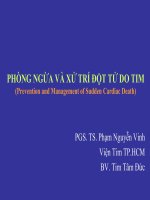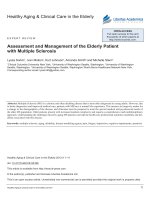Guideline for the evaluation and management of status epilepticus (SE) 2012 (the neurocritical care society)
Bạn đang xem bản rút gọn của tài liệu. Xem và tải ngay bản đầy đủ của tài liệu tại đây (1.15 MB, 18 trang )
GUIDELINE FOR THE
EVALUATION AND
MANAGEMENT OF STATUS
EPILEPTICUS (SE) 2012
(THE NEUROCRITICAL CARE SOCIETY)
Published: 24 April, 2012
Neurology Department
Vuong Chinh Quyen
INTRODUCTION
SE: requires emergent, targeted treatment
to reduce patient morbidity and mortality.
These guidelines were developed to
address evaluation and management of
SE in critically ill adults and children and
will not address the management of SE in
neonates.
DEFINITION
SE was defined as 5 min or more of
continuous clinical and / or electrographic
seizure activity
OR
recurrent seizure activity without recovery
(returning to baseline)between seizures
DEFINITION
This definition was adopted for the following
reasons:
Most clinical and electrographic seizures last
less than 5 min and seizures that last longer
often do not stop spontaneously
Animal data suggest that permanent neuronal
injury and pharmacoresistance may occur
before the traditional definition of 30 min of
continuous seizure activity have passed
More recently, experts have suggested a revised
definition of SE which includes seizures lasting
for 5 min or longer although some controversy
still remains
CLASSIFY
Convulsive SE: defined as convulsions that
are associated with rhythmic jerking of the
extremities
Non-convulsive SE: defined as seizure
activity seen on electroencephalogram (EEG)
without clinical findings associated with
generalised convulsive SE
Refractory SE: patients who continue to
experience either clinical or electrographic
seizures after receiving adequate doses of an
initial benzodiazepine followed by a second
acceptable antiepileptic drug (AED) will be
considered refractory
METHODOLOGY
A PubMed/Medline literature search was
performed for relevant articles published
through August 2011
Clinical trials, meta-analyses, review
articles, and practice guidelines were all
eligible for inclusion
EVIDENCE RATING SYSTEM
Class category
Level of evidence
I Intervention is useful and
effective.
II a Evidence/expert opinion
suggest intervention is
useful./effective.
II b strength of evidence/ expert
opinion about intervention
usefulness/effectiveness is less
well establish. More data are
needed; however, using this
treatment when warranted is
unreasonable
III Intervention is not useful or
effective or may be harmful.
A Adequate evidence is available
from multiple, large RCTs or metaanalyses
B Limited evidence is available
from less rigorous data , including
fewer, smaller RCTs,
nonrandomized and observational
analyses.
C Evidence relies on expert/
consensus opinion, case reports,or
standard of care
Critical care treatment
Critical care treatment
Non-invasive airway protection and gas exchange with
head positioning
Intubation (if airway/gas exchange compromised or
elevated ICP suspected)
Vital signs: O2 saturation, BP, HR
Vasopressor support of BP if SBP <90 mmHg or MAP
<70mmHg
Finger stick blood glucose
Peripheral IV access
1. Emergent initial AED therapy (i.e.benzodiazepine)
2. Fluid resuscitation
3. Nutrient resuscitation (thiamine given before dextrose;
dextrose)
Timing
0–2 min
0–10 min
0–2 min
5–15 min
0–2 min
0–5 min
Critical care treatment
Critical care treatment
Timing
Urgent SE control therapy with AED
Neurologic exam
Triage lab test panel
Refractory SE treatment
5–10 min
5–10 min
5 min
20–60 min after
2nd AED
0–60 min
15–60 min
Urinary catheter
Continuous EEG
Diagnostic testing (selection depends
on clinical presentation):CT, LP, MRI
Intracranial pressure monitoring
(depending on clinical presentation)
0–60 min
0–60 min
Treatment recommendations for SE
Emergent treatment
Class/Level of evidence
Lorazepam
Midazolam
Diazepam
Phenytoin/fosphenytoin
Phenobarbital
Valproate sodium
Levetiracetam
Class I, level A
Class I, level A
Class IIa, level A
Class IIb, level A
Class IIb, level A
Class IIb, level A
Class IIb, level C
Treatment recommendations for SE
Urgent treatment
Valproate sodium
Phenytoin/fosphenytoin
Midazolam (continuous
infusion)
Phenobarbital
Levetiracetam
Class/Level of evidence
Class IIa, level A
Class IIa, level B
Class IIb, level B
Class IIb, level C
Class IIb, level C
Treatment recommendations for SE
Refractory treatment
Class/Level of evidence
Midazolam
Propofol
Pentobarbital/thiopental
Valproate sodium
Levetiracetam
Phenytoin/fosphenytoin
Lacosamide
Topiramate
Phenobarbital
Class IIa, level B
Class IIb, level B
Class IIb, level B
Class IIa, level B
Class IIb, level C
Class IIb, level C
Class IIb, level C
Class IIb, level C
Class IIb, level C
Summary
1. The treatment of convulsive SE should occur rapidly
and continue sequentially until clinical seizures are
halted (strong recommendation, high quality).
2. The treatment of SE should occur rapidly and continue
sequentially until electrographic seizures are halted
(strong recommendation, moderate quality).
3. Critical care treatment and monitoring should be
started simultaneously with emergent initial therapy
and continued until further therapy is consider
successful or futile (strong recommendation, moderate
quality).
Summary
4. Treatment options
a. Benzodiazepines should be given as emergent initial
therapy (strong recommendation, high quality).
i. Lorazepam is the drug of choice for IV administration
(strong recommendation, moderate quality).
ii. Midazolam is the drug of choice for IM administration
(strong recommendation, moderate quality).
iii. Rectal diazepam can be given when there is no IV
access and IM administration of midazolam is
contraindicated (strong recommendation, moderate
quality).
Summary
4. Treatment options
b. Urgent control AED therapy recommendations include
use of IV fosphenytoin/phenytoin, valproate sodium, or
levetiracetam (strong recommendation, moderate quality).
c. Refractory SE therapy recommendations should
consist of continuous infusion AEDs, but vary by the
patient’s underlying condition (strong recommendation,
low quality).
d. Dosing of continuous infusion AEDs for RSE should be
titrated to cessation of electrographic seizures or burst
suppression (strong recommendation, very low quality).
e. A period of 24–48 h of electrographic control is
recommended prior to slow withdrawal of continuous
infusion AEDs for RSE (weak recommendation, very
low quality).
Summary
4. Treatment options
f. During the transition from continuous infusion AEDs in
RSE, it is suggested to use maintenance AEDs and
monitor for recurrent seizures by cEEG during the titration
period. If the patient is being treated for RSE at a facility
without cEEG capabilities, consider transfer to a facility that
can offer cEEG monitoring (strong recommendation, very
low quality).
g. Alternative therapies can be considered if cessation of
seizures cannot be achieved; however, it is recommended
to reserve these therapies for patients who do not respond
to RSE AED treatment and consider transfer of the patient
if they are not being managed by an ICU team that
specialize in the treatment of SE and/or cannot provide
cEEG monitoring (weak recommendation, very low quality).
PEDIATRIC SE
There is no evidence that children respond differently to
AED treatment than adults
Young children with epilepsy who develop SE should
receive IV pyridoxine in case they have pyridoxine
dependent seizures
Concern exists for possible hepatotoxicity when using
valproate sodium in younger children (<2 years of age),
especially those with a metabolic or mitochondrial
disorder.
There have been several pediatric series that have used
diazepam as a continuous infusion with doses ranging
from 0.01 to 0.03 mcg/kg/min to control RSE, but this is
not a widely used current practice
Thanks for your attention!









